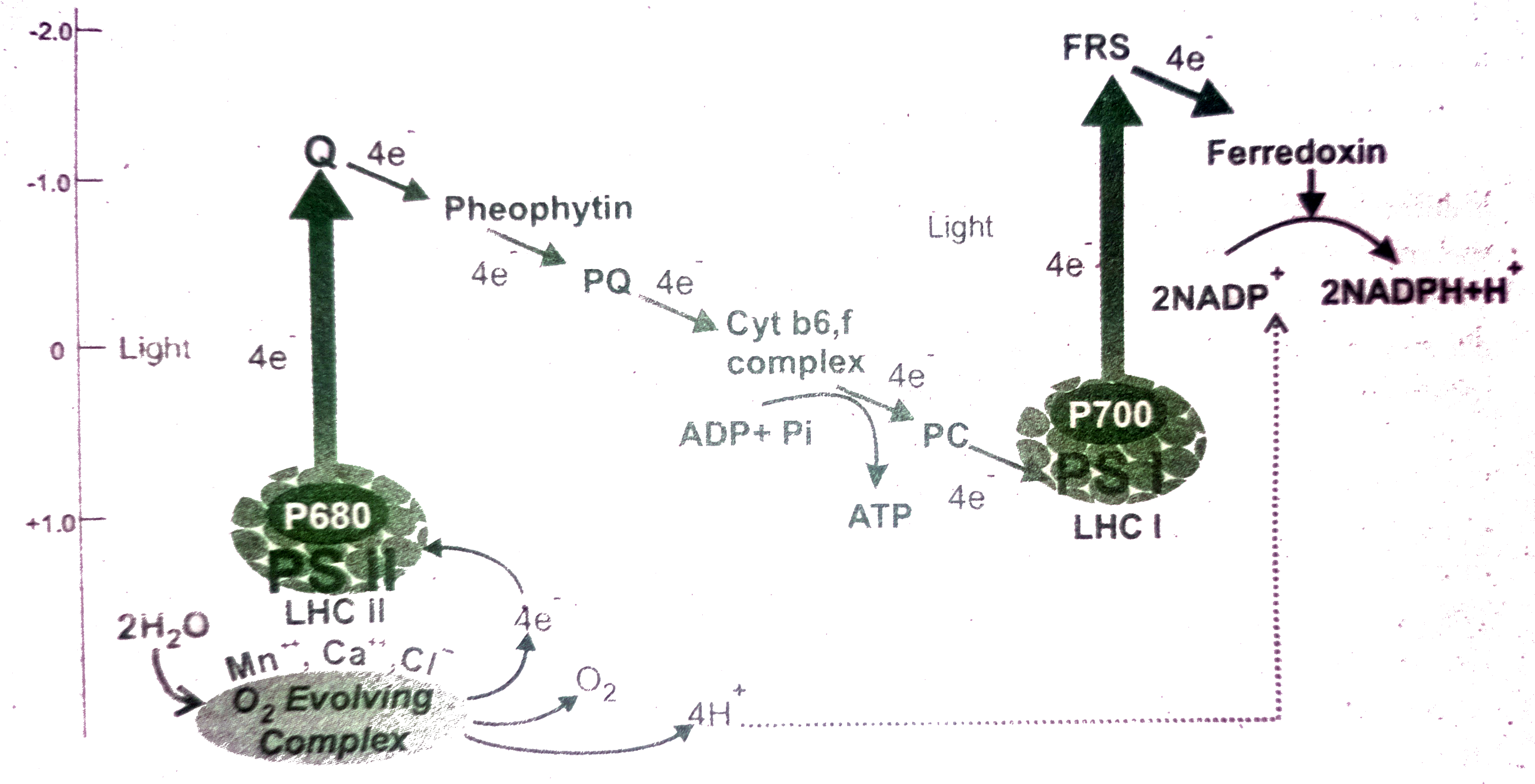Explain non-cyclic photophosphorylation.Solution in Tamil
When photons are activated reaction centre of pigment system II(P680), electrons are moved to the high energy level. Electrons from high energy state passes through series of electron carriers like pheophytin, plastoquinone, cytochrome complex,

plastocyanin and filly accepted by PS I (P700). During this movement of electrons from PS II to PS I ATP is generated. PS I (P700) is activated by light. electrons are moved to high energy state and accepted by electron acceptor molecule ferredoxin reducing Substance (FRS). During the downhill movement through ferredoxin, electrons are transferred to DP+ and reduced into DPH+H+ (H+ formed from splitting of water by light).
Electrons released from the photosystem II are not cycled back. It is used from the reduction of DP+ in to DPH + H+. During the electron transport it generates ATP and hence this type of photophosphorylation is called non-cyclic photophosphorylation. The electron flow looks like the appearance of letter .Z. and so known as Z scheme.
When there is availability of DP+ for reduction and when there is splitting of water molecules both PS I and PS II are activated. Non-cyclic electron transport PS I and PS II both are involved co-operatively to transport electrons from water to DP+. In oxygenic species non-cyclic electron transport takes place in three stages.
(i) Electron transport from water to P680: Splitting of water molecule produce electrons, protons and oxygen. Electrons lost by the PS II (P680) are replaced by electrons from splitting of water molecule.
(ii) Electron transport from P680 to P700: Electron flow starts from P680 through a series of electron carrier molecules like pheophytin, plastoquinone (PQ), cytochrome b6−f complex, plastocyanin (PC) and filly reaches P700 (PS I).
(iii) ELectron transort from P700 to DP+: PS I (P700) is excited now and the electrons pass to high energy level. When electron travels downhill through ferredoxin, DP+ is reduced to DPH + H+.
Topper's Solved these Questions
- PHOTOSYNTHESISBOOK - PREMIERS PUBLISHERSCHAPTER - PHOTOSYNTHESISEXERCISE - Other Important Questions & Answers CHECK YOUR GRASP
3 Videos
- PHOTOSYNTHESISBOOK - PREMIERS PUBLISHERSCHAPTER - PHOTOSYNTHESISEXERCISE - Other Important Questions & Answers -III. Answer the following. (3 Marks)
12 Videos
- NEURAL CONTROL AND CO-ORDINATION BOOK - PREMIERS PUBLISHERSCHAPTER - NEURAL CONTROL AND CO-ORDINATION EXERCISE - SOLUTION TO TEXTUAL QUESTIONS(Text Book Page No. 71)
1 Videos
- PLANT GROWTH AND DEVELOPMENT BOOK - PREMIERS PUBLISHERSCHAPTER - PLANT GROWTH AND DEVELOPMENT EXERCISE - OTHER IMPORTANT QUESTIONS & ANSWERS (ANSWER THE FOLLOWING) (5 MARKS)
8 Videos
Similar Questions
Name the products produced from Non-Cyclic photophosphorylation?
View SolutionMention the significance of photosynthesis.
View SolutionYour friend is returning home after his visit to USA. All at home are waiting for his arrival. How would you feel? State the division of ANS that predominates and mention few changes that take place in your body.
View SolutionDescribe the geometric growth rate in plants with sutable diagram.
View SolutionNon Cyclic Photophosphorylation
View SolutionNon-cyclic photophosphorylation is performed by
View SolutionNon-cyclic photophosphorylation involves
View SolutionNon-cyclic photophosphorylation produces
View SolutionIn non-cyclic photophosphorylation
View Solutionনিম্নলিখিতগুলির মধ্যে তুলনা করো- চক্রাকার ফটোফসফোরাইলেশন এবং অচক্রাকার ফটোফসফোরাইলেশন
View SolutionExplain non-cyclic photophosphorylation.
View SolutionCyclic photophosphorylation : PS I :: Non-cyclic photophosphorylation : ..............
View SolutionNon-cyclic photophosphorylation differs from cyclic photophosphorylation in:
View Solutioncyclic photophosphorylation differs from non-cyclic photophosphorylation in formation of
View SolutionNon-cyclic photophosphorylation differs from cyclic photophosphorylation
View SolutionNon-cyclic photophosphorylation differs from cyclic photophosphorylation in that the form
View Solution
